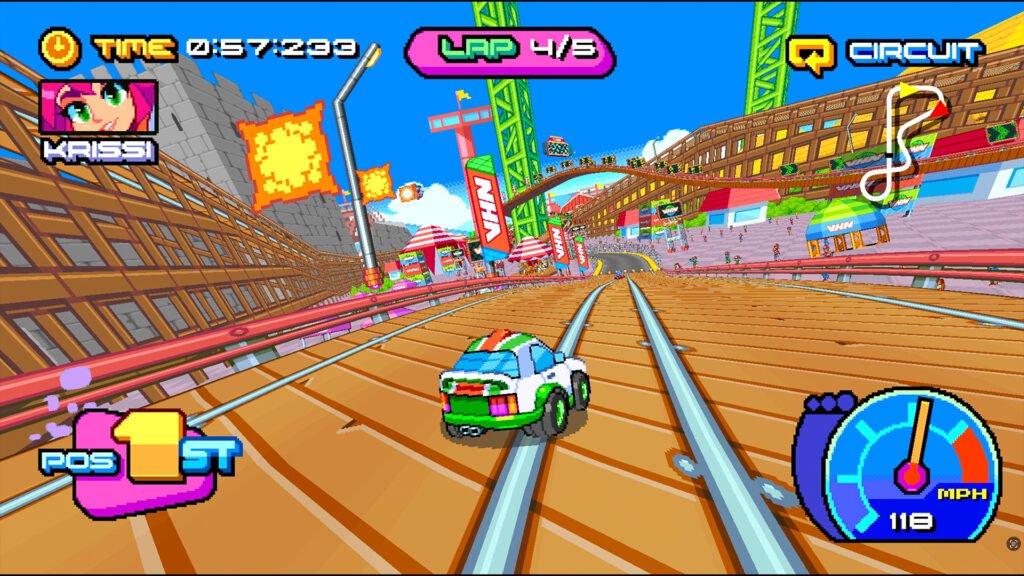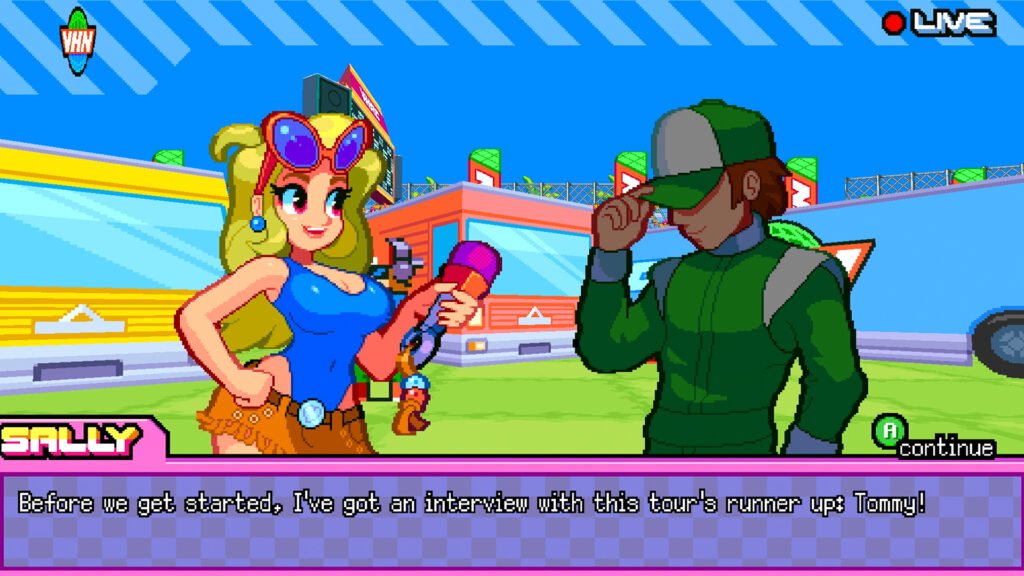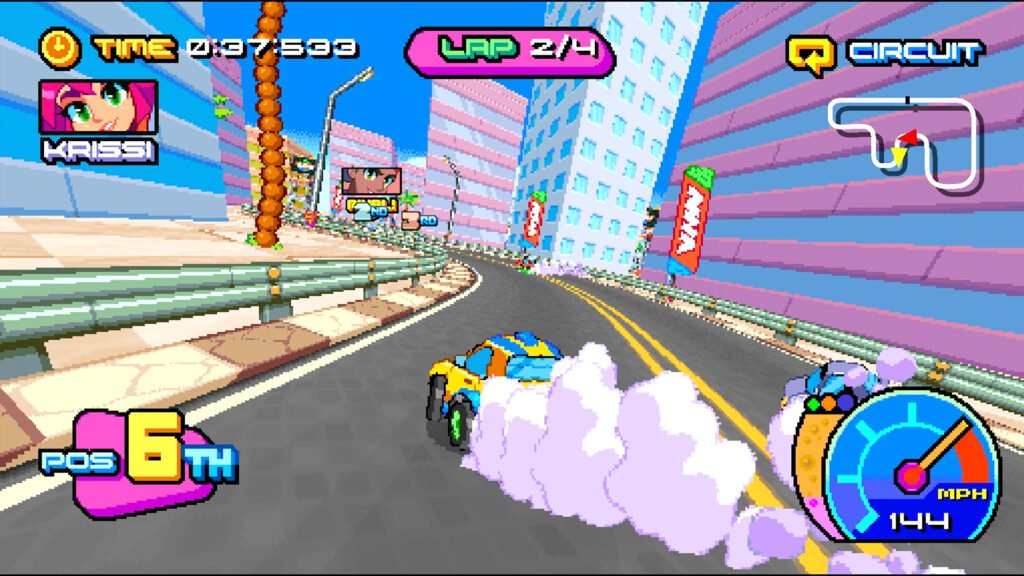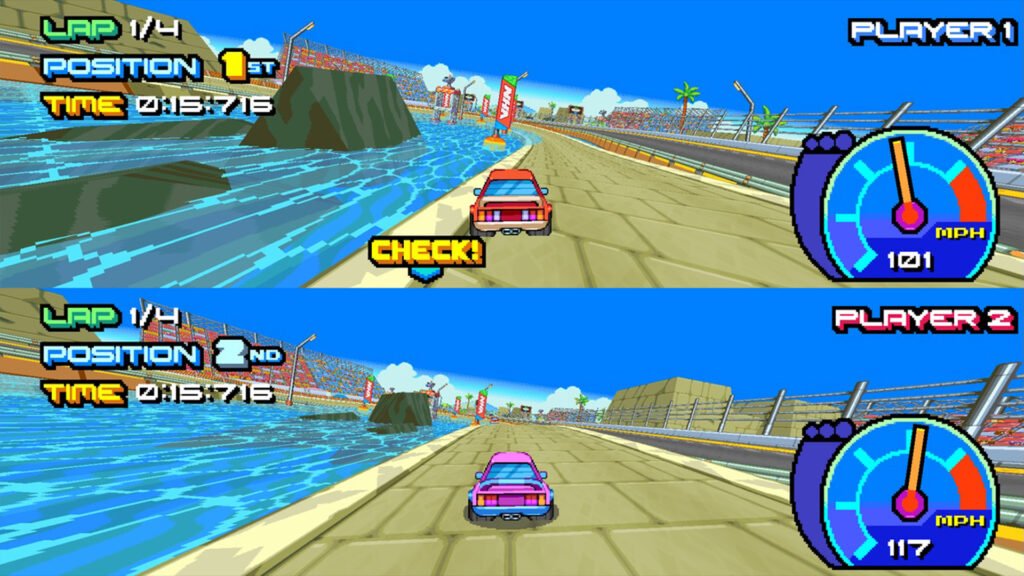Retro arcade racing fans are a bit spoilt for choice at the moment. Hot on the heels of the sublime New Star GP and the Early Access promise of Super Retro GP, comes this 2D/3D hybrid from developer Skydevilpalm. Victory Heat Rally is a homage to Sega’s Super Scaler coin-ops of the late 1980s, in particular 1988’s Power Drift.
That means super-fast racing action, rollercoaster-esque track design and a camera view that (optionally) tilts when you turn. Of course, 2024’s tech means it’s all super-slick and clean. But is it any fun? That’s the kicker.
When you strip away all the highlighter pen visuals, party music electronica and the world map that makes the game look more involved than it really is, the gameplay is of the most basic variety. It has accelerate, brake, left and right controls, and a special ‘drift’ button that you hold while cornering to fill your boost bar. In true Mario Kart 8 fashion, that means three boost levels depending on how well you can drift around the corners.

But that’s it for the races and rally events (which play like races but with arrows instead of a track map). You steer left and right, and drift around the corners, which means you never have to use the brakes unless you’re in one of the side missions like slaloming through gates or hitting every cone around the course. Given you rarely slow down for anything, chances are you’re going to win everything once you’ve nailed the driving mechanics.
Sure, newcomers will take longer to learn it so early wins may be more rewarding to start with, but for Traxion readers who live and breathe racing games, it’s just way too basic. Indeed, when you’re out in front, you gain the ability to smash lapped cars off the road, almost as if the developers knew the game would be boring when you’re out in front, but even these wanton acts of destruction soon lose their appeal.

The game gets harder and the tracks more complex as you go, but winning all but some 10 races over the whole four-hour runtime isn’t much fun, though the developer has announced it is examining player feedback about difficulty for the next patch.
There are rivals to race and eventually unlock as playable characters, and split-screen local multiplayer which runs beautifully, and will certainly add challenge if you have a similarly-skilled friend to play with. But aside from going back and getting gold on everything you missed the first time, the solo experience ends just as it’s getting good. Ironically, the last race certainly demonstrates what the whole game could be like, with a breathless ride coupled with ultra-close racing against similarly skilled AI.
But most of all it’s worth noting the shortcomings compared to its muse, Power Drift. In Sega’s cult classic, you can see the drivers themselves during races and they exude personality, whereas here the cars have opaque windows so competitors are faceless.

Power Drift’s tracks are extreme in their undulations, giving you a ‘hanging on for dear life’ feeling whereas this game’s vertical elements won’t be changing the colour of your knuckles unless you’re really new to racing games.
Power Drift requires serious skill to navigate its courses and crashing out will lose you the race, almost guaranteed, while here on the few occasions you do crash, it resets you just a couple of metres back from where you would have been. And it has to be said, Power Drift doesn’t need to go to Horny Jail. Some of the characters here are dressed a little… unusually.

From a technical standpoint, it runs well but not flawlessly on an nVidia RTX 2070-enabled Dell G3 laptop, exhibiting infrequent frame pacing issues and slowdown, but it runs much better on a Steam Deck, targeting a lovely, smooth 60fps. There’s also a screen filter for pixelated graphics if you want that 80s aesthetic in full, which certainly looks neat.
There’s an argument to say all games should be judged on their own merits, especially when holding an indie game up to a AAA classic, albeit one from 36 years ago. With that in mind, this is a decent-looking, slick and accessible racer that’s worth playing to enjoy its style and zoom about for a bit, but with disappointingly shallow gameplay it probably won’t hold your attention for very long, at least in this first incarnation.

| Developer | Skydevilpalm |
| Release date | 3rd October, 2024 |
| Available platforms | PC (Switch coming soon) |
| Version/s tested | PC |
| Best played with | SteamDeck |






Chat with the Community
Sign Up To CommentIt's completely Free